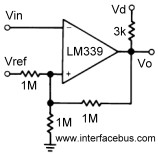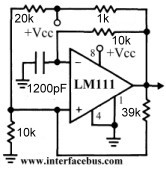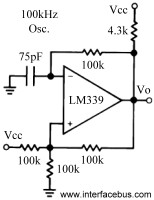General Engineering Terms
"A"
"B"
"C",
"D",
"E",
"F",
"G",
"H",
"I",
"J",
"K",
"L",
"M",
"N",
"O",
"P"
"Q",
"R",
"S",
"T",
"U",
"V",
"W",
"X",
"Y",
"Z"
Voltage Comparator
A voltage comparator is a device that compares the voltage at the two inputs and develops an output based on the inputs. A high output when the plus input is greater than the minus input or a low output when the plus input is less than the minus input. |  Comparator |
A comparator is a component that compares the two analog inputs and outputs a digital signal that represents which input signal is greater than the other. An acceptable analog input depends on the actual voltage comparator used and the voltage used to power it. The digital output can be almost any digital signal and again depends on the comparator and the voltage used to power it. However; the outputs might include an Open Drain, Open Collector, TTL Totem Pole, LVDS, or Push-Pull, to list the most common. So even though the input is analog, the output could directly interface with many of the TTL logic families.
Although the voltage comparator is not an operational amplifier, an application might still use the terms inverting and non-inverting. An inverting voltage comparator would apply a signal to the minus input while the plus terminal is fixed to a voltage reference. The non-inverting voltage comparator would apply the signal to the plus input while the minus terminal is fixed to a voltage reference. So the terms apply to an input being above a reference and than having the output switch either high [non-inverting] or low [inverting].
Common Applications
A zero crossing detector may be produced by applying the input to the plus terminal and grounding the minus terminal. The output goes high when the input goes above the ground reference.
Hysteresis may be added to a voltage comparator by applying feedback. The configuration begins to appear like an operational amplifier circuit, but the circuit is still a comparator and will never function as an Op-Amp. The input resistor [Ri] and the feedback resistor [Rf] determine the voltage hysteresis [Vh]. Vh = Ri/(Rf + Ri) |  Comparator |
The 1 Meg resistor between the plus input and ground is just a compensation resistor and not part of the hysteresis function. The 3k pull-up resistor between Vcc and the output sets the voltage level of the output. The example voltage comparator used is an LM339 which uses an open-collector output, which means the output needs to be pulled high to some level. The Vcc voltage need not be the same voltage that is used to power the device, and can be changed to accommodate different output interfaces. For example the output could be pulled to 5 volts to interface with 5 volt TTL logic or 3.3 volts to interface with that series of parts [regardless of the power being supplied to the IC].
Voltage Comparator Package Options
Voltage comparators are available in the same package options as operational amplifiers. The through-hole packages may be either Plastic DIP Package, or Ceramic DIP Package [for military and space applications], while the surface mount versions will be in a SOIC Package. The standard package contains 14 pins and holds four individual comparators, as the LM339 defines a quad package. A 14 pin LM339 in a plastic DIP, produced by STMicroelectronics, is shown to the right. The letter N after the part number signifies a plastic DIP package.
Voltage Comparator Unused Inputs
Voltage comparators are also different from operational amplifiers when it comes to unused devices within a package. Unused inputs on a voltage comparator need to be tied to the negative voltage supply; again this differs from an Op-Amp.











